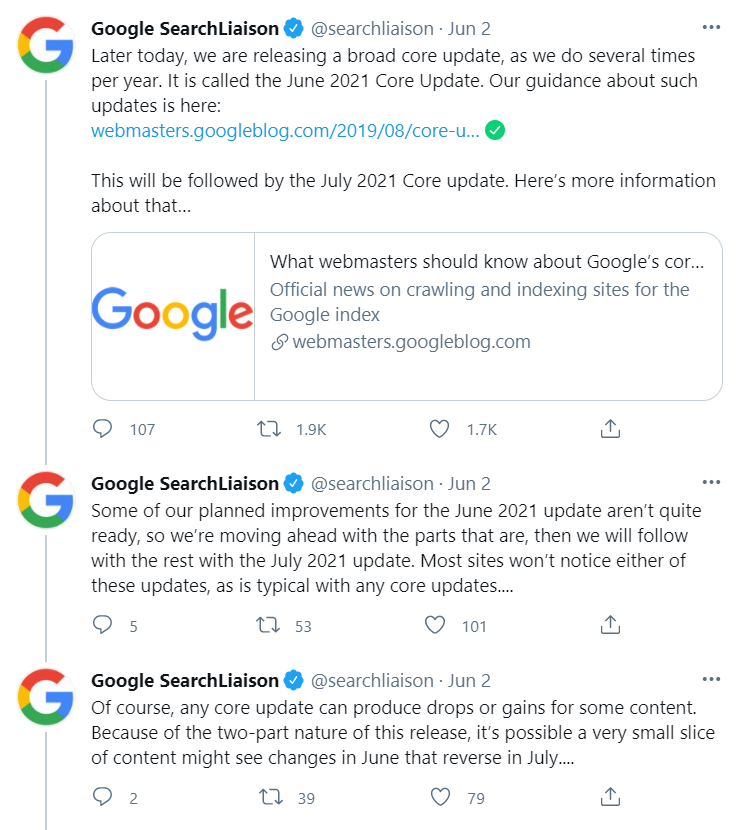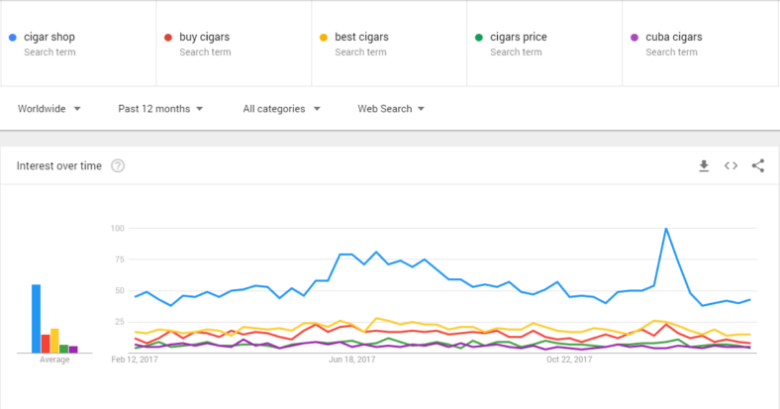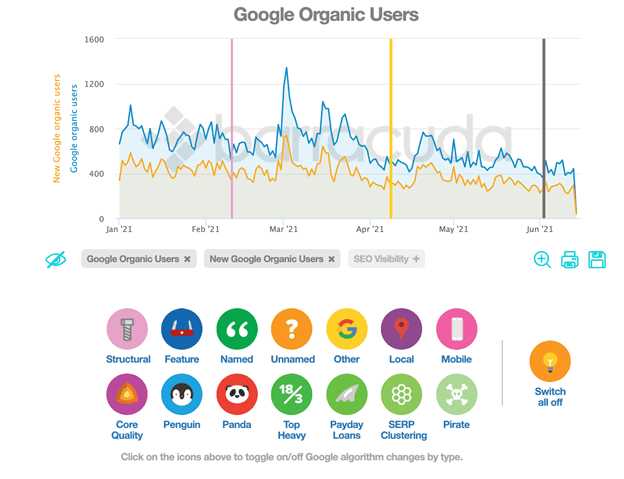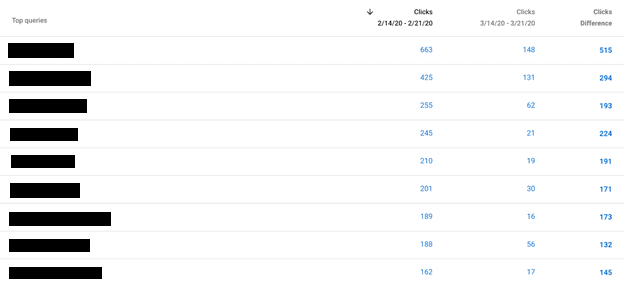Just in case SEOs aren’t busy enough, Google is keeping us all on our toes with more core algorithm updates than ever.
Just as we recovered from 2022’s Helpful Content Update, 2023 came in with a bang, giving us the February Product Reviews update and the March core update following closely behind.
You can bet Google’s continuously tinkering behind the scenes between each and every update — leaving us digital marketers to play catchup while anxiously awaiting news of the next algo update.
Today, we’re sharing our approach to post-update SEO for eCommerce websites. In this guide, you’ll learn:
- Why we’re not too worried about it (no, really)
- Which tools we use to evaluate post-update site performance
- Which contributing performance factors we watch for
- And what we recommend for eCommerce websites
Need an expert to review your website performance post-algo update? We offer an Algorithm Update Analysis to get the answers you’re looking for. Contact our team to schedule your site review today.
A Brief History of Recent Updates
Before we get into the nitty-gritty, let’s recap the last few Google search ranking updates we’ve seen, starting with the unprecedented year that was 2021.
In a rare move, Google split its summer 2021 broad core algorithm update (known as the “Page Experience Update”) into two parts released over two months. At the same time, Google finalized its user-experience-focused Core Web Vitals update in June 2021, confusing many marketers who attempted to attribute organic traffic changes to one update or another.

Google’s final 2021 update rolled out in November, giving us more than six months of breathing room before the next one would rear its head.
In May 2022, Google returned to form with a one-part summer update, which rolled out over the course of a few weeks.
Just a few months later, the search engine rolled out its Helpful Content Update in August, aimed to reward “people-first” content amid a rise of AI-generated content.
We saw a second part of that update to round out 2022, with the latest Google core algorithm update hitting this March.
For a comprehensive look at Google’s core algorithm update history, check out this compilation from Search Engine Land.
The Hard Truth: The Damage is Already Done
Whether your eCommerce site is recovering from algorithm updates in 2022, 2021, or even earlier, take comfort in knowing that no quick fixes could have saved you from harm.
Google’s webmasters are notoriously vague about which ranking signals are tweaked when each core update is released, meaning you can’t make last-minute changes to your site to avoid a hit to your organic traffic.
As we all know, SEO is a long game. The only way you can “take advantage of” a broad core update is to already be implementing a solid eCommerce search engine optimization strategy of quality content across your site.
However, in some cases — like the long-awaited Core Web Vitals update in 2021 — Google will provide helpful tools for analyzing your site’s current performance ahead of time, giving you benchmarks to work toward. (If you haven’t already, use the Page Speed Insights tool to check your site, and then learn how to improve your Core Web Vitals scores accordingly.)
That’s why we highly recommend working with an expert SEO professional who stays up to date on any latest news, so they can prep your site as needed.
eCom Business? No Need to Worry
We’ve been shepherding dozens of eCommerce brands through Google updates for more than a decade, and the vast majority have avoided any volatility in performance due to updates. In fact, most of their sites keep moving like nothing has happened, even after the various product review updates of the past few years. (While these updates weren’t expected to impact eCommerce sites as an industry, we still closely monitored our metrics — just in case.)
Save any upcoming eCommerce-specific updates, we anticipate the same for the future.
That’s not to say that you shouldn’t care. Even if a core update doesn’t affect your site, it’s still a good indicator of how Google’s algorithm is evolving and good education for your ongoing SEO strategy.
We recommend paying close attention to what digital marketing leaders are reporting, so you can adjust your long-term approach to what is (and isn’t) performing well for the SEO community.
How to Evaluate a Google Core Update’s Effects on Your Site
Admittedly, there’s a lot of mystery wrapped around Google’s ranking algorithm updates, but you don’t have to be in the dark about its effects on your site.
For the most recent update (and future ones to come), identify any significant changes to your organic performance by following our approach:
Step 1: Monitor site performance during the rollout period.
Google will frequently announce upcoming core updates ahead of time, so you’ll know exactly when to start looking for traffic changes. Most updates take a few weeks to roll out completely; when evaluating site traffic, look at a time span of about a month for the most accurate picture.
If your site has felt an impact from the update, it will be easy to see.
Here are some examples of surges I’m seeing. Some of the sites seeing increases have been waiting a long time (and have worked very hard to improve). I hope this sticks for them. Remember, the July update could reverse some this… Time will tell. pic.twitter.com/PeG9DjZQSM— Glenn Gabe (@glenngabe) June 6, 2021
We initially use Google Analytics 4 to evaluate any core update effects on our client’s sites. Our strategists typically check traffic reports every day (or every few days, depending on the size of the update) for a few weeks following the confirmed update.
The video below is hosted on YouTube. If you need assistance with viewing the video, please contact [email protected].
As mentioned, most of our eCommerce clients’ sites haven’t historically been impacted by recent updates — but, if they were, we’d see it in Google Analytics right away.
Step 2: Look for seasonality.
If a Google core update is rolled out during your business’s slow or busy season, you’ll need to rule out seasonality as a contributing effect.
Let’s say your online store sells school supplies. If you see a jump in traffic and revenue after this summer’s update, it may not be an effect of the update at all — just a normal increase in parents getting ready for the back-to-school season.
If your site sees a change in traffic after a Google core algo update, look at week-over-week, month-over-month, and year-over-year trends. Compare the results; if this traffic change is new to this summer, it could be an indication that the Google update has affected your site.
Another example: One of our former eCommerce clients (a seller of cigars and cigar products) was concerned about a drop in organic traffic following a Google update in the winter of 2017. But, when we compared their January 2018 performance with that from a year before, we saw the same drop in traffic:

Don’t have accurate YOY data to mine? You can also compare your site with Google’s overall trends.
Here, we see a steep drop in “cigar shop” interest around January, indicating our client’s drop in traffic was indeed due to seasonality, not that winter’s Google update.

Of course, remember that YOY comparisons may not be 100% accurate, depending on COVID-19’s effect on your industry in 2020 and onward. We recommend comparing multiple years, just in case. (Here at Inflow, we’ve been using 2019 as a “baseline” for most of our clients.)
You can also look at competitors’ performance to confirm a seasonality drop.
Using these processes, we were able to eliminate the update as a contributing factor, understanding that this change was just a normal drop-off in cigar interest around the new year, perhaps due to New Year’s resolutions.
Step 3: Consider searcher intent.
Even if you see a drop in traffic to your site after a Google update, it may not necessarily be harmful. Google often uses core updates to clean up keyword search results, reducing the number of irrelevant web pages for search queries.
If your site was inadvertently ranking for an unrelated keyword or topic, the core update may have fixed that mistake — or, in the case of our own site, introduced the error!
While unrelated to a core update, an unconfirmed change in Google’s algorithm caused Inflow’s organic clicks to spike on March 25, 2021. Just a few days later, they dropped back down to normal levels.

Upon further investigation, we found out that our guide to Majestic SEO had suddenly started ranking in the Google search results for the phrase “explain the majestic benefits” — likely searched by students trying to avoid doing their homework for an unrelated topic. When it became clear that our guide was an irrelevant result, Google’s algorithm made the adjustment to the search engine results pages (SERPs).
Ranking for irrelevant keywords isn’t uncommon, especially in eCommerce sites with thousands of blog, product, and category pages. If you see similar session or ranking fluctuations over the next month, make sure to look at your revenue. If conversions and revenues are holding steady (or increasing!), there’s likely no reason to worry.
Irrelevant keywords may have been the source of the traffic change, not a negative hit from the core update.
Rather have an expert complete this post-update SEO audit for you? Contact us today to request your Algorithm Update Analysis from our expert SEO team.
What to Do if Your Organic Performance Drops
If your website traffic takes a hit after a Google update, and it can’t be explained by seasonality, keyword cleanup, or another obvious reason, try to confirm the algorithm’s effects through additional tools, and then reevaluate your overall SEO strategy.
Step 1: Connect the free Panguin tool to Google Analytics.
The Panguin tool (not to be confused with the Penguin update!) is one of our favorites for evaluating the timelines of Google’s updates as they compare to our site’s performance. It’s easy; authorize Panguin to view your Google Analytics data, and the tool will overlay Google’s updates on your performance data.

You can use the Panguin tool to look at older Google core updates and their effects, too.
Step 2: Check for patterns with Google Search Console.
If your site sees an unexplainable drop or increase in traffic, identify exactly where those changes are coming from with Google Search Console.
We use Google Search Console to see if a pattern of page types or keyword buckets has dropped or increased in search traffic.
See our example below:
Within a space of two months, one client saw a steep drop in clicks to a certain group of keywords. While this particular example was unrelated to a Google algo update, if there had been an update around this time, this pattern would indicate we needed to look into the site performance a little closer.

By comparing this data with core update reporting from SEO experts, we can then determine whether those patterns are in line with the suspected algorithm changes. (Although Google typically doesn’t give details for which types of pages and industries are affected by a core update, digital marketers can often deduce what they are based on with a little detective work.)
If we see a similar pattern in page or keyword type, we automatically know what to focus on as we reevaluate our SEO strategy for that site.
Often, the pages that take a hit are those we’re already aware of — those with thin content, overly long content, or other low-quality SEO approaches — and give our clients even more motivation to tackle those issues.
Step 3: Reevaluate your SEO efforts.
Not all Google algorithm updates are obvious. Usually, it’s difficult to identify exactly which technical and content SEO strategies are being rewarded with core updates. We just see the final result in which kinds of industries and websites are most affected.
However, a core update can be the motivation your brand needs to reevaluate your current SEO strategies. If you’ve got thin website content, now’s the time to beef up your SEO copywriting techniques; if your tech SEO setup leaves something to be desired, get a developer on the phone.
Some of the biggest SEO offenses we see from eCommerce sites?
- Lack of content on product and category pages
- Poorly optimized content on product and category pages
- Extensive blog-like content on product and category pages
- Technical site speed and performance issues (especially in regard to mobile search)
Solving these issues now will put your site in better shape for the Google core updates of the future.
Start identifying these common issues with our DIY guides:
- eCommerce Content Audit Toolkit
- How to Conduct a Technical SEO Site Audit for eCommerce
- Content Consolidation & Pruning: Complete Guide
The Best Core Update Defense: A Good SEO Offense
When it comes to Google’s core updates, the best use of your time isn’t trying to “game the system” with backlinks and other quick fixes; it’s creating a long-term, well-rounded SEO strategy that builds high-quality content based on proven strategies.
Need some help figuring those out? Our SEO strategists are always happy to help. (Contact us anytime for a free proposal.)
We also recommend digital marketers and eCommerce brands stay up to date on Google’s algorithm changes as they continue to roll out. For the best real-time coverage of ongoing updates, check out reporting from:










Thank you so much for sharing, now I have additional ideas on how to check if the update has slightly or considerably affected the website. Thanks for sharing the DIY guides, it’s really helpful as well.